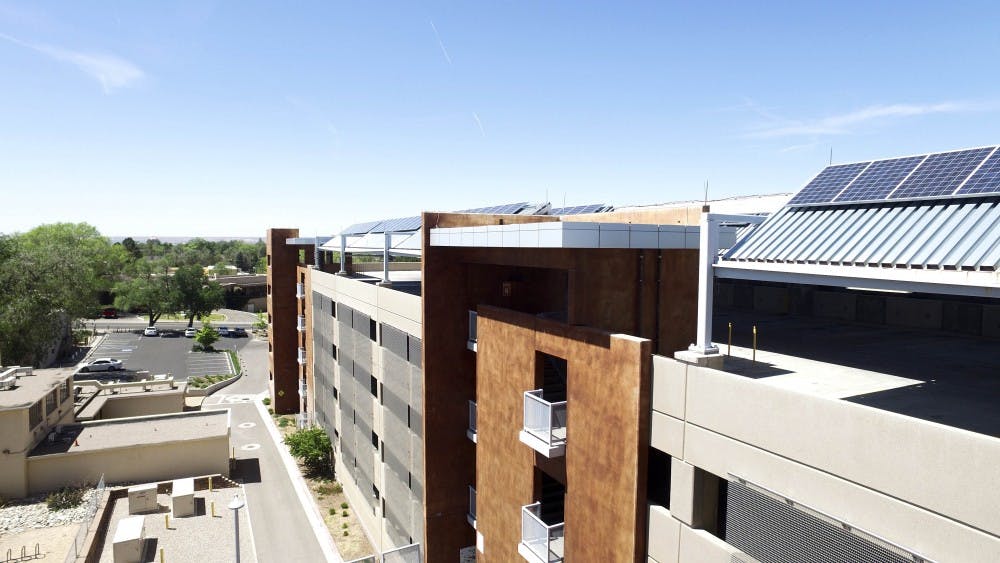A resolution to push the University of New Mexico toward 100 percent renewable energy was passed unanimously through the Associated Students of UNM Senate during their Oct. 25 meeting.
The resolution, introduced by ASUNM senators Emily Hartshorn and Madeline Starkweather, encourages the University to take “concrete steps” in the transition to alternative energy sources.
Starkweather, a junior majoring in biology and a co-sponsor of the resolution, said the purpose of this resolution is to bring awareness that sustainability is an important topic to the Lobo community.
Hartshorn, the author of the resolution, said the benefits of 100 percent renewable energy could include: saving money on utilities, providing education and research opportunities for students and allowing UNM to become a leader in renewable energy, in hopes that it will create more jobs.
To outline the logistics of implementing solar energy at UNM, Hartshorn and Starkweather sought the expertise of Environment New Mexico.
Nansi Singh, the legal intern for Environment New Mexico, said by pursuing 100 percent renewable energy, UNM could help lead New Mexico toward a “clean energy future.”
In a previous press conference held at UNM, Environment New Mexico released their 10-point plan that aims to help universities progress to 100 percent renewable energy. The group said New Mexico could be a leader in alternative energy, because it is the second sunniest state and the 12th windiest.
Starkweather said she is hopeful the resolution will be successful with the knowledge on how to reach their goal — thanks to Environment New Mexico — and the access to student support through ASUNM.
“This isn’t their first rodeo,” she said. “They know what they’re doing and what needs to be done and most likely what is the best way to do that. So I’m hopeful.”
This is not the first time the University administration has been urged to move towards a more sustainable campus.
In 2009, UNM’s Sustainability Council introduced a Climate Action Plan that aimed to reduce 70 percent of the emissions produced by the Albuquerque campus in 2006, by the year 2030 — it also called for UNM to become carbon neutral by 2050.
Starkweather said the difference between the 2009 plan and the new resolution is the determination of both the Senate and students across campus to create a more “clean” University.
Get content from The Daily Lobo delivered to your inbox
“A lot of them are very broad goals — a lot of them are maybe really long-term goals,” she said. “But it starts that dialogue.”
Since the introduction of the Climate Action Plan, UNM has installed nine solar systems — seven on Main Campus, which produces 467 kilowatts of energy total, and one on UNM West and the Valencia Branch Campus.
Mary Clark, the manager of the Office of Sustainability at UNM’s Physical Plant Department, said as long as UNM has the funding, a solar project will be installed every year. Installations will mainly focus on buildings that are powered by PNM to reduce the costs of buying energy from the company.
Starkweather said large buildings like Johnson Center and the SUB are on her list for solar panel installations.
It would be advantageous to look at alternative energy sources for those buildings, because the University does not receive state funding toward utilities for buildings that are not used for education or research, Clark said.
Since the 2009 plan was signed, no other climate plans or reduction plans have been produced, but the UNM-Taos campus has “already committed to 100 percent solar,” according to the resolution — adding to the pressure on the University to respond.
Starkweather said she was not aware of any direct response from the University after publishing the resolution.
She acknowledged the yearly solar installations across campus but said she hopes to push for more.
“It’s great that UNM is taking step on its own, but for us it’s not enough, because there’s always more that we can do,” she said.
Student support was not on the list of obstacles for Starkweather. Instead, she said financials are always a big concern.
It is not clear at this moment where the University would get the money for expanding their solar projects. When asked if the money would come from student fees, Starkweather was unable to give an answer but said the source of the money depends on what building would receive solar panels.
For the current yearly installations, Clark said it should be noted that if the state continues to cut funding and the enrollment rates maintain their decline, going “solar” is not feasible at this time.
In the wake of decreased enrollment rates, pledging to create a clean campus is something Singh and Starkweather said could only increase the notoriety of UNM and draw students in.
Starkweather said a lowered energy bill should be noted as a long-term benefit of solar panels that the University should see as a positive investment.
Despite the financial challenges, Starkweather said she feels it is a safe investment.
“(Solar panels) are tried, they’re true, they’re proven to really be efficient, to really do what they’re supposed to do and last a long time,” she said.
Getting support from the administration is a big step that needs to be taken, Starkweather said.
She said the new president, Garnett S. Stokes, gives her hope that ASUNM can work together with the “big guys” on environmental initiatives.
“I think we can put together a team that’s realistic — something that’s not planning for something they can’t achieve or is kind of dreaming,” Starkweather said.
She said UNM has all of the resources needed to move to a “greener” campus — the brain power, the student support and the help of an environmental organization.
Next on her agenda, Starkweather said, is to continue to build support for the resolution from the UNM student body, staff and faculty and figure what buildings would benefit the most from solar energy and how feasible it would be.
“It’s up to (the administration) now,” she said. “We can continue to prod this idea towards them. If it gets brushed under the rug, we’ll write another one.”
Madison Spratto is a news editor for the Daily Lobo. She can be contacted at news@dailylobo.com or on Twitter @Madi_Spratto.






